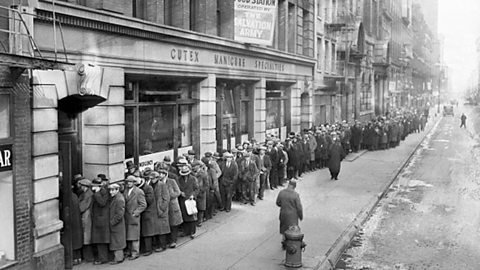Life during the Great Depression
The Great Depression affected American people’s lives in a number of ways. In towns, as businesses went bankruptA legal status where a person or organisation is ruled to be unable to pay their debts. people lost their jobs and found it difficult to get more work. In the countryside, people lost their farms. This led to people from both towns and the countryside wandering America looking for work.
The unemployed and the homeless
There was no national welfare stateA state (or country) where the government provides welfare benefits, such as education, health care and unemployment payments, to its population free at the point of use, although they are paid for by general taxation. in the USA. Therefore, people who lost their jobs had to rely on what little help was available from their state government, local churches and charities. This support system was quickly overwhelmed, especially in places with high unemployment - in some locations, it was over 50 per cent.
Every day, unemployed people queued outside businesses that were still operating, hoping to be given work. When people lost their jobs, they lost the ability to feed themselves and their family. Queues of people outside charity soup kitchens waiting to be fed were called breadlineA line in which people in extreme poverty, who did not have the money to buy food for themselves or their families, queued up for food handouts. People also lost their homes as they could no longer afford to pay their mortgageA mortgage is a type of loan. It is usually a large amount of money used to pay for a property. or their rent.

Different workers lost their jobs for different reasons. Racial prejudice meant that African American workers were typically among the first to lose their jobs and were often the last people many businesses would consider hiring. Recent immigrants to the USA had the same problem. Women at that time mostly worked as servants. However, they lost their jobs as people could no longer afford to pay them.
Hoovervilles
Some people dealt with losing their homes by building temporary places to live in public parks using tents, cardboard boxes and corrugated iron sheets. These temporary places had no sanitation and grew into unofficial villages and towns. However, the people who lived in them developed a sense of community and looked after each other. These communities became known as HoovervillesA name for shanty towns, which are large settlements consisting of very poor-quality housing, built during the Great Depression. They took their name from President Herbert Hoover. as the people who lived in them blamed President Herbert Hoover for not doing enough to help them.
Hobos
It is estimated that, 2 million Americans travelled across the country on foot, in cars or on the railroad looking for work and somewhere to live. Most of them were men but some were women or children. They were referred to as hobosWorkers who travelled around the country looking for work.
The Bonus March
The US government had promised to pay a bonus to war veterans who had fought in World War One. This bonus was due to be paid in 1945, but some people thought that it should be paid early. In March 1932, a group of between 20,000 and 40,000 unemployed war veteranA person who has served in the armed forces. and their families marched to Washington on the Bonus March, demanding that their bonuses be paid early. Roughly 15,000 veterans chose to stay in a Hooverville built outside the Capitol Building, the meeting place of the CongressThe legislative body of the US government, made up of the Senate and the House of Representatives.
Congress refused to pay the bonus but offered to pay for the marchers to get back home. Police were sent in to break up the marchers’ camp, but the marchers fought back to try to prevent this. President Hoover sent in troops with tear gas and tanks to remove the marchers and their Hooverville.
This made President Hoover even more unpopular. It looked as if he did not care about people’s suffering due to the problems caused by the Great Depression.